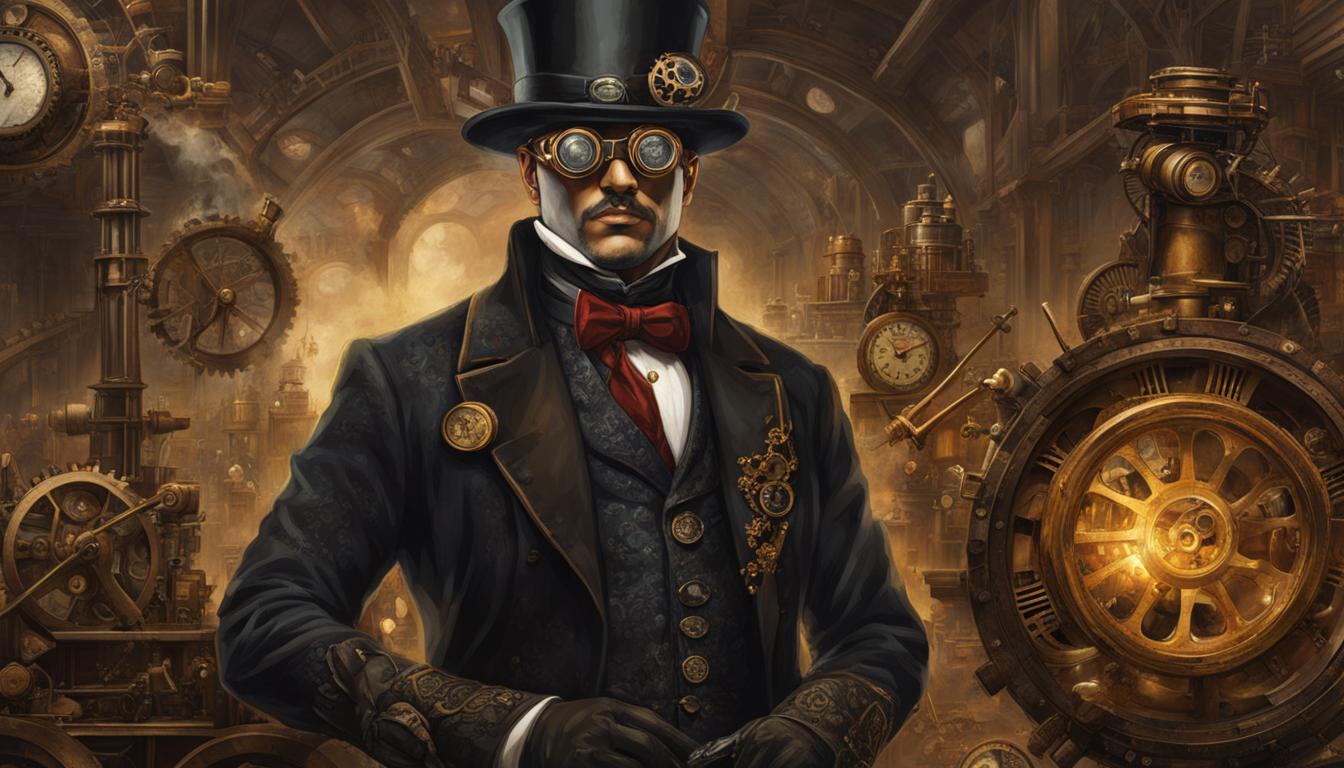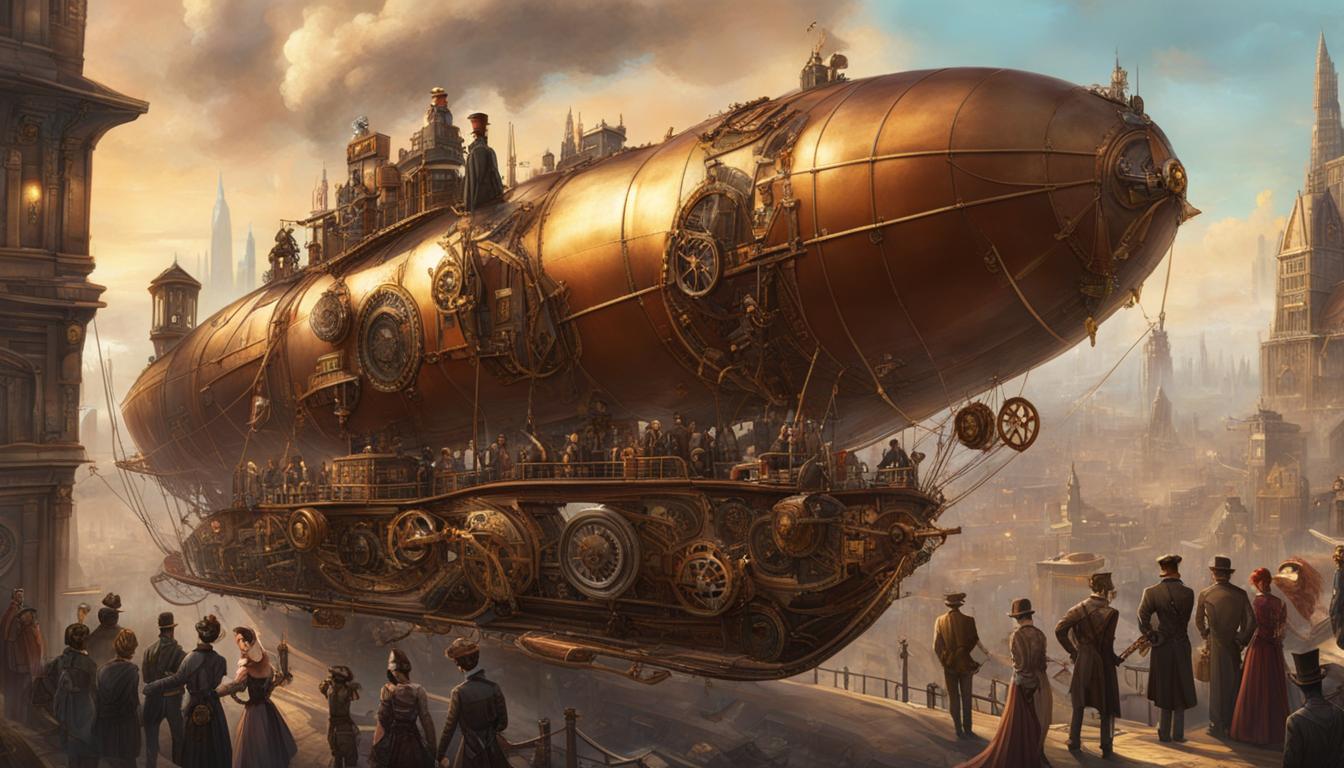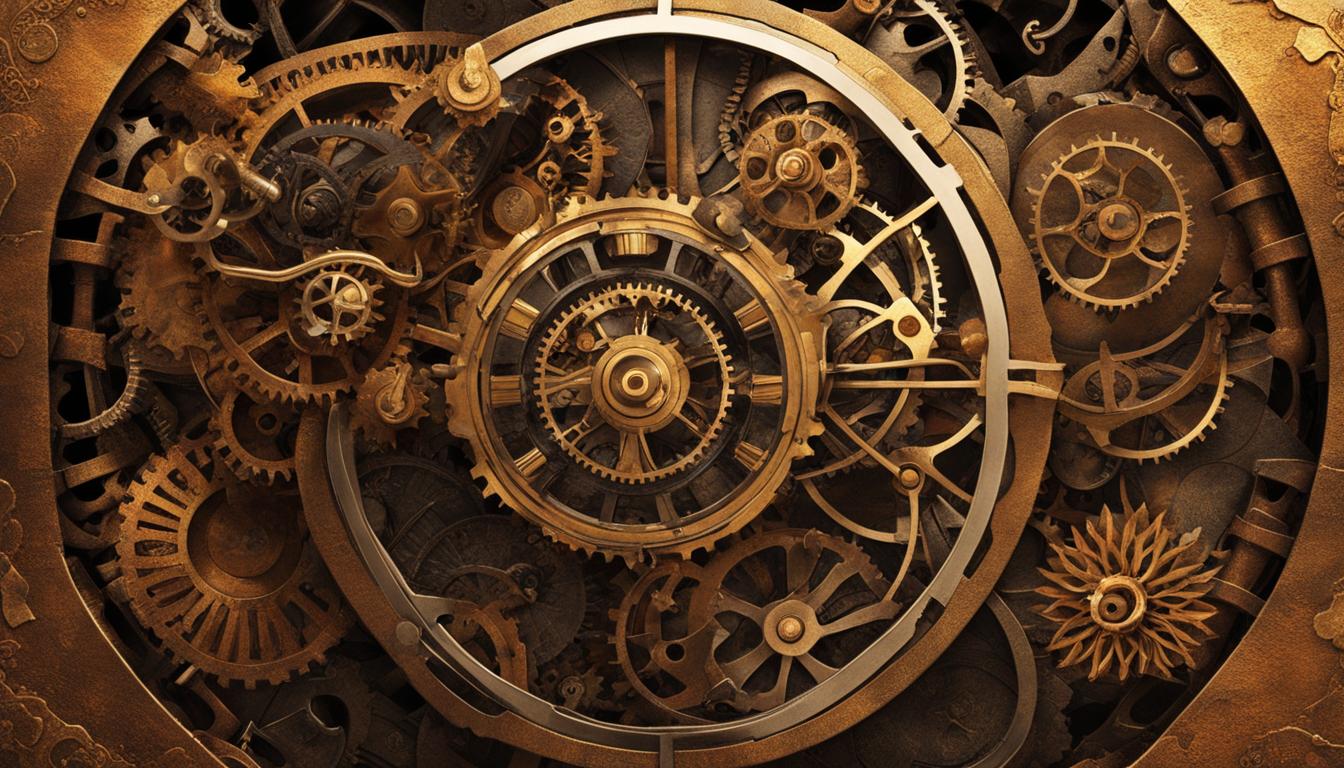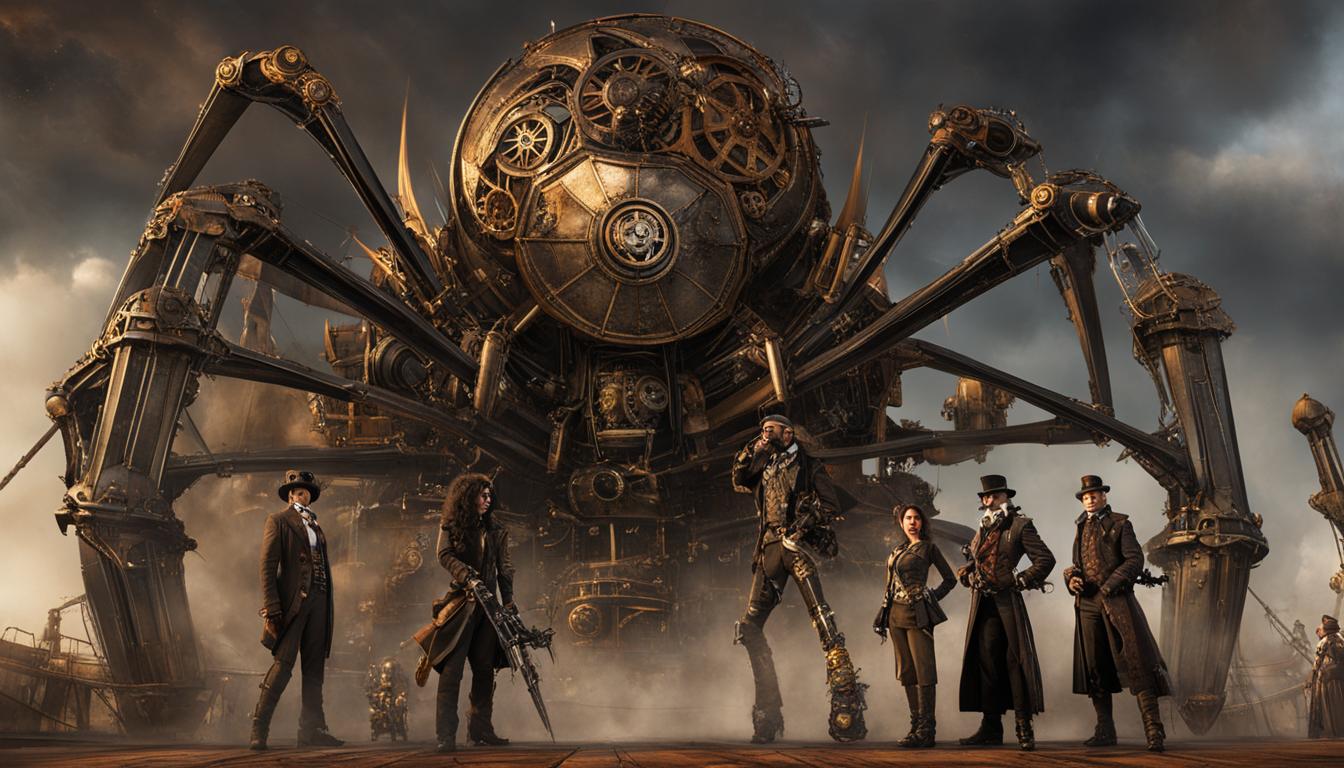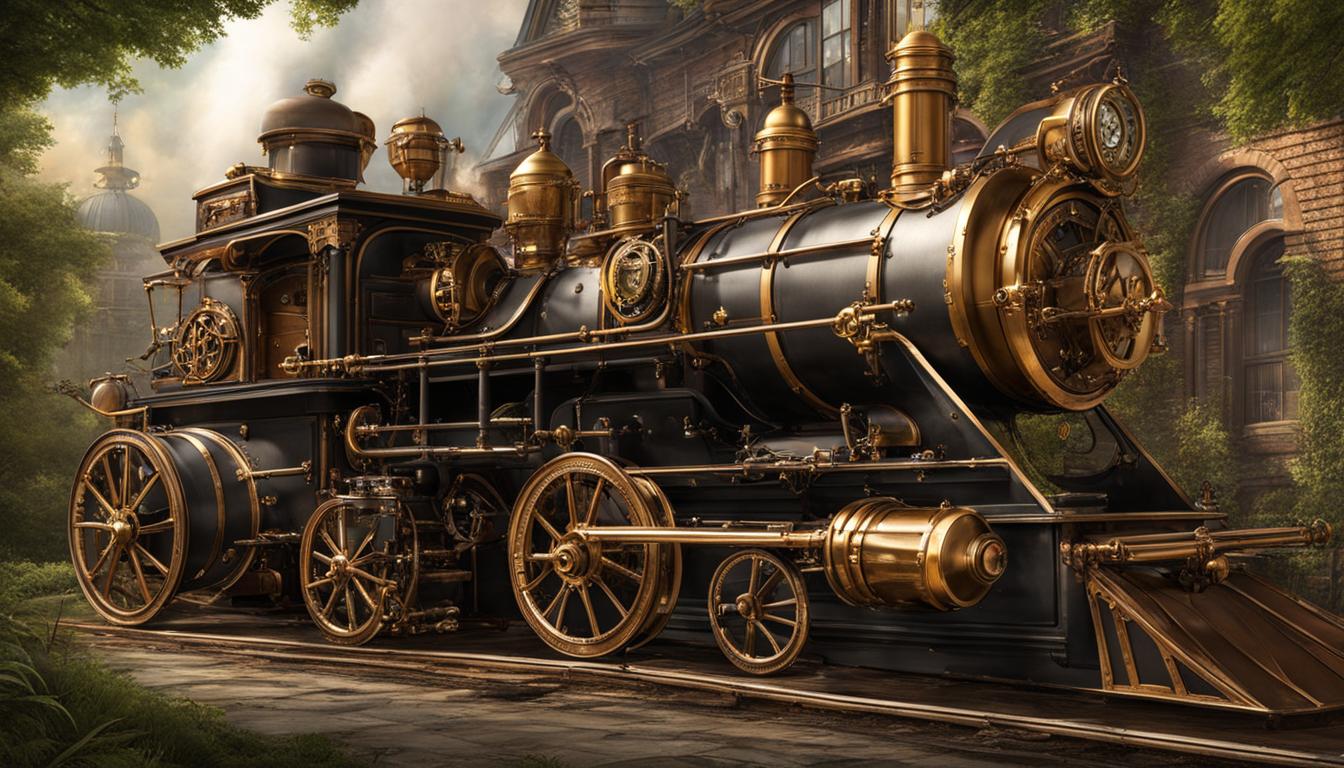Step into a world where the Victorian era collides with futuristic ideas, and steam-powered technology reigns supreme. Welcome to the captivating realm of steampunk, a subgenre of science fiction that offers a fresh perspective on historical power dynamics. By exploring alternative histories and reimagining the social hierarchies of the Victorian era, steampunk invites us to question the dynamics of power and the potential for change.
Steampunk is more than just a whimsical blend of history and imagination; it’s a lens through which we can reexamine the power struggles and imbalances that defined the past. Join us as we delve into the world of steampunk, exploring its subgenre, common themes, popular works, and the importance of research in crafting authentic steampunk stories. Discover how steampunk authors create captivating worlds filled with retrofuturistic technology, and how the city of Santa Cruz becomes a unique backdrop for steampunk narratives.
Key Takeaways:
- Steampunk combines elements of the Victorian era with futuristic ideas and steam-powered technology.
- By reimagining historical power dynamics, steampunk offers a unique perspective on social hierarchies.
- Themes of rebellion, innovation, and social reform are common in steampunk narratives.
- Notable steampunk works include “The Difference Engine,” “Mortal Engines,” and “Boneshaker.”
- Research and attention to historical context are essential in crafting authentic steampunk stories.
Understanding the Steampunk Subgenre
Steampunk, a captivating subgenre of science fiction, draws inspiration from the Victorian era and the Industrial Revolution. It offers a unique blend of history and imagination, combining elements of the past with futuristic ideas. Steampunk narratives often explore alternative historical narratives, transporting readers to worlds filled with steam-powered technology and retrofuturistic wonders.
In the Victorian era, the Industrial Revolution brought about significant advancements in steam technology, powering machinery that transformed industries and propelled society forward. Steampunk authors take these historical elements and reimagine them, pushing the boundaries to create worlds where steam technology has advanced even further. Airships gracefully glide through the skies, mechanical automatons carry out intricate tasks, and retrofuturistic medical advances promise revolutionary breakthroughs.
Through the lens of steampunk, readers can immerse themselves in a richly detailed world that reflects the social context of the Victorian era while offering imaginative twists. The subgenre explores themes of innovation, rebellion, and social reform, with characters challenging the norms of oppressive regimes and exposing power imbalances. By delving into alternative histories, steampunk narratives invite readers to critically examine and reevaluate historical power dynamics.
| Victorian era elements | Steampunk adaptations |
|---|---|
| Industrial Revolution | Retrofuturistic steam technology |
| Rigid social hierarchies | Characters challenging oppressive norms |
| Advancements in steam-powered machinery | Airships and mechanical automatons |
Steampunk subgenre provides a unique platform for authors to explore historical contexts and inspire readers with its imaginative worldbuilding. By fusing elements of the past and future, steampunk captivates the imagination and invites us to question the power dynamics of history.
Additional Information on Steampunk Subgenre
Steampunk subgenre has gained popularity across various forms of media, including literature, film, and fashion. Influenced by literary works like Jules Verne’s “20,000 Leagues Under the Sea” and H.G. Wells’ “The Time Machine,” the genre has evolved into a vibrant community of enthusiasts and creators. Steampunk conventions and events showcase intricate costumes, imaginative gadgets, and a shared passion for the subgenre’s aesthetic and themes.
- Quotes:
Steampunk is a delightful blend of history and fantasy, where the past collides with the future, and imagination knows no bounds. It offers an escape into a world of steam, gears, and adventure.
By reimagining the Victorian era through the lens of steampunk, we are reminded of the power of human ingenuity and the potential for change.
In summary, the steampunk subgenre draws inspiration from the Victorian era and the Industrial Revolution, offering a unique blend of history and imagination. By reimagining historical elements and pushing the boundaries of steam technology, steampunk narratives provide a fresh perspective on power dynamics and invite readers on thrilling adventures through retrofuturistic worlds.
Common Themes in Steampunk Narratives
Steampunk narratives captivate readers with their rebellious spirit, innovative ideas, and exploration of social reform. These themes provide a fresh perspective on power struggles and imbalances, often set in alternative historical contexts. By challenging conventional norms and delving into alternative histories, steampunk stories inspire readers to question the status quo and imagine a world of possibility.
Innovation is a core element of steampunk narratives, with characters often harnessing the power of steam technology to create impressive inventions. The fusion of Victorian aesthetics and futuristic steam-powered machinery creates a captivating blend of past and future. This unique combination sparks the imagination and invites readers to envision a world where scientific progress knows no bounds.
Steampunk narratives push the boundaries of social norms, offering a platform for characters to challenge oppressive regimes and fight for justice. These stories shine a light on power struggles and imbalances, emphasizing the importance of social reform in creating a more equitable society.
One of the defining characteristics of steampunk is its exploration of alternative history. By reimagining the past, steampunk stories allow readers to examine the present from a different perspective. This alternative history not only serves as a backdrop for the narrative but also prompts reflection on the choices and actions that shape our own reality.
Examples of Common Themes in Steampunk Narratives:
- Rebellion against oppressive regimes
- Innovation and technological advancements
- Social reform and pursuit of justice
- Power struggles and imbalances
- Exploration of alternative historical narratives
By weaving together these common themes, steampunk narratives offer readers a rich and immersive experience that challenges the limitations of reality and invites them to explore new possibilities.
Popular Steampunk Novels
Steampunk literature has captured the imaginations of readers with its unique blend of historical elements and futuristic technology. From thrilling adventures to thought-provoking narratives, there are several notable steampunk novels that have become beloved in the genre.
The Difference Engine
One of the seminal works in steampunk, “The Difference Engine” by William Gibson and Bruce Sterling explores an alternative 19th century where Charles Babbage’s mechanical computer, the Analytical Engine, becomes a reality. Set in a Victorian era filled with steam-powered technology, political intrigue, and technological advancements, this novel delves into the social and political implications of a world shaped by computational innovation.
Mortal Engines
Philip Reeve’s “Mortal Engines” takes readers on a thrilling journey through a post-apocalyptic world where cities have become mobile and prey on one another. In this steampunk adventure, Reeve examines themes of power, greed, and survival while exploring the consequences of a society driven by technological progress and territorial dominance.
Boneshaker
Cherie Priest’s “Boneshaker” introduces readers to an alternate 19th century where a devastating disaster has transformed Seattle into a toxic wasteland. The novel follows the adventure of a determined mother as she ventures into the dangerous city, facing air pirates, zombie-like creatures, and a hidden family legacy. With its action-packed plot and vivid portrayal of a steampunk-infused Seattle, “Boneshaker” has become a beloved addition to the genre.
Perdido Street Station
China Miéville’s “Perdido Street Station” offers a complex and immersive steampunk world set in the city of New Crobuzon. This dark and atmospheric novel explores themes of rebellion, corruption, and the consequences of scientific experimentation. Miéville’s intricate worldbuilding and richly detailed characters make “Perdido Street Station” a must-read for fans of the genre.
Airborn
Kenneth Oppel’s “Airborn” takes readers on a high-flying adventure aboard airships in a world where the skies are the new frontier. The novel follows the journey of Matt Cruse, a cabin boy on the airship Aurora, as he becomes entangled in a mystery involving a rare creature and hidden treasures. With its thrilling plot and vivid descriptions of airborne exploration, “Airborn” offers a unique perspective on the steampunk genre.
| Title | Author | Summary |
|---|---|---|
| The Difference Engine | William Gibson and Bruce Sterling | An alternate 19th-century world where steam-powered technology and Charles Babbage’s Analytical Engine shape society. |
| Mortal Engines | Philip Reeve | A post-apocalyptic world where cities are mobile and prey on one another, exploring themes of power and survival. |
| Boneshaker | Cherie Priest | An alternate 19th-century Seattle filled with air pirates, zombies, and a determined mother’s quest for answers. |
| Perdido Street Station | China Miéville | A dark and atmospheric city of New Crobuzon, where rebellion and scientific experimentation collide. |
| Airborn | Kenneth Oppel | An adventure aboard airships in a world where the skies hold secrets and treasures. |
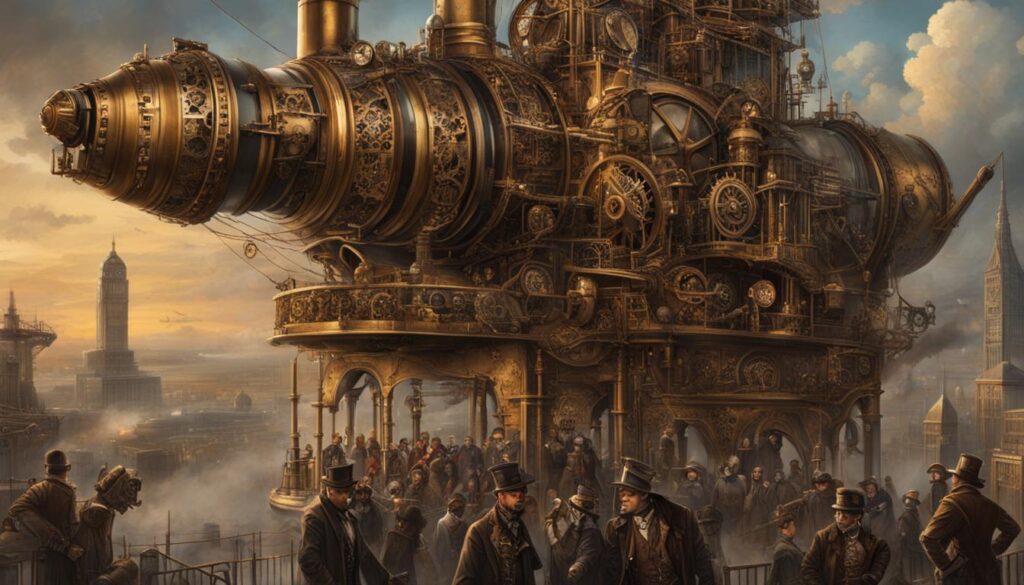
Retrofuturistic medical advances also play a significant role in the steampunk world. These advancements, often driven by steam-powered technology, enable characters to overcome previously incurable illnesses and injuries. The blending of historical medical practices with imaginative innovations creates a sense of wonder and possibility within the narrative.
Finally, the steampunk world thrives on alternative energy sources. While the Victorian era relied primarily on coal and steam, the steampunk world introduces alternative energy sources such as the luminiferous ether. This mysterious and fictional energy source fuels advanced technologies and opens up new possibilities for exploration and scientific advancements.
Steampunk worldbuilding is a journey into a retrofuturistic realm where historical elements intertwine with imaginative concepts. From airships soaring through the skies to mechanical automatons performing complex tasks, the steampunk world offers a visually captivating and intellectually stimulating setting for storytelling.
Santa Cruz: The Real and Fictional Steampunk Haven
Deep in the heart of the steampunk world, the city of Santa Cruz reigns as a captivating backdrop for thrilling narratives. In the realm of the Creedverse, Santa Cruz takes on a new identity, blending historical divergences with the allure of retrofuturistic technology. At the center of this steampunk wonderland lies the enigmatic Locke Regulator Company, an iconic symbol of innovation and power.
In the steampunk adaptation of Santa Cruz, historical divergences shape the fabric of this vibrant city. As you traverse its streets, prepare to encounter a unique blend of the Victorian era and retrofuturistic technology. Imagine the gas lamps casting an otherworldly glow upon the cobblestone alleys, while airships hover gracefully above, propelled by steam and dreams. It’s a place where time bends, offering an exhilarating mix of history and imagination.
A visit to Santa Cruz is a journey through time, where the familiar intertwines with the fantastical, and the possibilities are as limitless as the steam that powers the city.
The Locke Regulator Company: Pioneers of Retrofuturistic Marvels
Within Santa Cruz, the Locke Regulator Company stands as a testament to the relentless pursuit of technological advancement. This fictional company, renowned for its ingenuity, produces a myriad of retrofuturistic marvels. From mechanical automatons that intricately mimic human behavior to ingenious devices harnessing the mysterious energy sources of the Creedverse, the Locke Regulator Company is at the forefront of innovation.
Steampunk enthusiasts find themselves captivated by the Locke Regulator Company’s creations, which reflect the intricate craftsmanship and technological prowess of the Victorian era. The city’s inhabitants, ever in awe of the company’s inventions, rely on these cutting-edge contraptions to navigate their daily lives amidst a world touched by both the past and the future.
| Steampunk Inventions | Description |
|---|---|
| Automaton Servants | These mechanical marvels function as loyal and diligent assistants, seamlessly integrating into households and society. |
| Aether-Powered Communicators | Revolutionizing long-distance communication, these devices utilize the luminiferous ether as a medium to transmit messages. |
| Vaporous Transportation Systems | These intricately designed vehicles utilize compressed steam, offering a swift and efficient means of travel across the city. |
| Pneumatic Medical Apparatus | Steampunk medical advances are a testament to the ingenuity of the Locke Regulator Company, providing innovative treatments and diagnostics powered by steam and clockwork mechanisms. |
Visiting Santa Cruz in the Creedverse is akin to stepping into a world of wonder, where reality and fantasy intertwine. As you immerse yourself in the rich tapestry of the steampunk city, let your imagination soar amidst the gears, steam, and retrofuturistic marvels that define the enchanting realm of Santa Cruz.
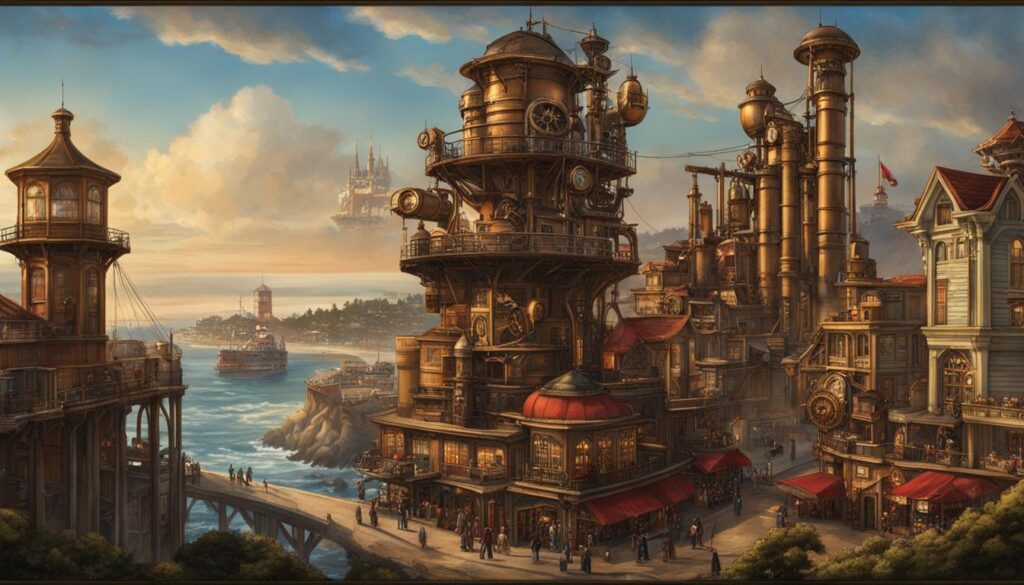
Steampunk Santa Cruz: A Captivating Fusion
The fusion of historical divergences, the Locke Regulator Company’s inventive spirit, and retrofuturistic technology make steampunk Santa Cruz a captivating destination for literary explorations. It invites readers to indulge in imaginative adventures that challenge convention and inspire critical thinking about the intricate dynamics of power.
Prepare to embark on a journey like no other, where the allure of steampunk storytelling meets the mysterious charm of Santa Cruz. Step through the veil of retrofuturism and allow yourself to be transported to a realm where gears turn, airships soar, and the spirit of innovation reigns supreme.
Conclusion
Steampunk, with its captivating blend of history and imagination, offers a unique lens through which to reexamine power dynamics in the past. By exploring themes of rebellion, innovation, and social reform, steampunk narratives challenge traditional notions of authority and invite readers to question the status quo. Through the imaginative storytelling of the steampunk genre, readers are transported to alternative histories where steam-powered technology shapes the world and reshapes power dynamics.
Through its fusion of real and fictional elements, steampunk provides a refreshing and engaging storytelling experience. It encourages historical reexamination by presenting alternative narratives that challenge prevailing power structures. By imagining a world where steam technology has advanced even further, steampunk invites readers to question the limitations of the past and consider the possibilities of the future.
Steampunk serves as a reminder that power is not fixed or immutable, but rather a dynamic force that can be reshaped and redefined. Its imaginative stories inspire readers to think critically about the dynamics of power and to reflect on the potential for change in their own lives and societies. Steampunk’s ability to captivate and entertain while offering a fresh perspective on historical power dynamics makes it a truly remarkable and influential genre.
FAQ
What is steampunk?
Steampunk is a subgenre of science fiction that combines elements of the Victorian era with futuristic ideas.
What does steampunk explore?
Steampunk explores alternative historical narratives in worlds filled with steam-powered technology, offering a unique lens to reexamine historical power dynamics.
What is the inspiration behind steampunk?
Steampunk draws inspiration from the Victorian era and the Industrial Revolution, incorporating steam-powered machinery and reflecting the transformative power of the Industrial Revolution.
What are common themes in steampunk narratives?
Rebellion, innovation, and social reform are common themes in steampunk stories, challenging conventional norms and highlighting power struggles and imbalances.
Can you recommend any notable steampunk works?
“The Difference Engine” by William Gibson and Bruce Sterling, “Mortal Engines” by Philip Reeve, “Boneshaker” by Cherie Priest, “Perdido Street Station” by China Miéville, and “Airborn” by Kenneth Oppel are notable steampunk novels.
How important is research in steampunk writing?
Research is crucial in crafting authentic steampunk stories, as understanding the historical context, technological advancements, and social dynamics adds depth to the narrative.
How does worldbuilding play a role in steampunk storytelling?
Worldbuilding is vital in steampunk storytelling, as the steampunk world combines historical elements with retrofuturistic technology, such as airships, mechanical automatons, advanced medical practices, and alternative energy sources.
How does Santa Cruz fit into the steampunk genre?
In the fictional Creedverse, Santa Cruz takes on a new identity, blending historical elements with retrofuturistic technology, featuring the fictional Locke Regulator Company and serving as a captivating setting for steampunk narratives.
What does steampunk offer as a storytelling experience?
Steampunk offers a captivating and imaginative lens to reexamine historical power dynamics, challenging traditional narratives and inviting readers to think critically about the dynamics of power through its fusion of history and imagination.

